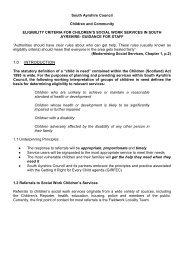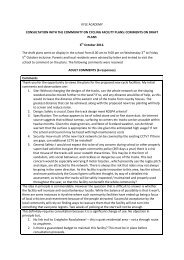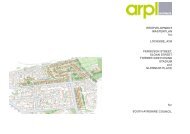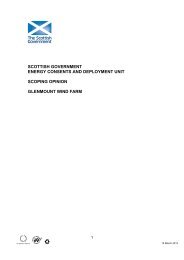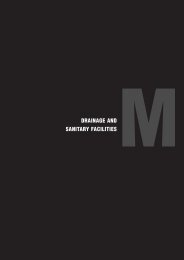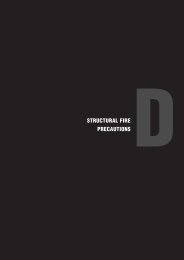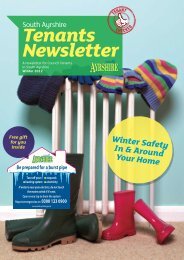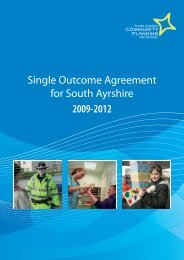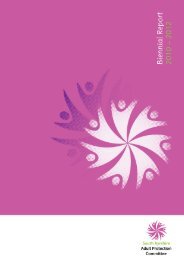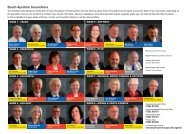childrenspanelscotland.org - South Ayrshire Council
childrenspanelscotland.org - South Ayrshire Council
childrenspanelscotland.org - South Ayrshire Council
You also want an ePaper? Increase the reach of your titles
YUMPU automatically turns print PDFs into web optimized ePapers that Google loves.
<strong>childrenspanelscotland</strong>.<strong>org</strong>
A Brief Background<br />
join The Children’s Panel. It’s life changing.
Children’s Hearings:<br />
a Brief Background<br />
The Foundation of the Children’s<br />
Hearings System<br />
Scotland’s Children’s Hearings system represents one of the radical<br />
changes initiated by the Social Work (Scotland) Act 1968, now<br />
incorporated in the Children (Scotland) Act 1995.<br />
There was a concern in the late 1950s and early 1960s that change was<br />
needed in the way society dealt with children and young people in<br />
trouble or at risk. A Committee was therefore set up in 1960 under Lord<br />
Kilbrandon to investigate possible solutions. The Committee reported<br />
in 1964. It found that children and young people appearing before<br />
courts, whether they had commited offences or were in need of care<br />
and protection, had common needs. The Committee considered that the<br />
existing juvenile courts were not suitable for dealing with these problems<br />
because they had to combine the characteristics of a criminal court with<br />
an agency making decisions on welfare. Separation of these functions<br />
was therefore recommended. The establishment of facts (where they<br />
were disputed) was to remain with the courts, but decisions on what<br />
action was needed in the welfare interests of the child were to be the<br />
1<br />
join The Children’s Panel. It’s life changing.
esponsibility of a new and unique kind of hearing. On 15 April 1971<br />
Children’s Hearings took over from the courts most of the responsibility for<br />
dealing with children and young people under 16, and in some cases<br />
under 18, who commit offences or who are in need of care and protection.<br />
In 2011, a new Act, the Children’s Hearings (Scotland) Act 2011 was<br />
passed. The Act strengthens and modernises the system and includes<br />
the appointment of a National Convener and the creation of a new body,<br />
Children’s Hearings Scotland. The Act will not be fully implemented until<br />
late 2012. While there will be procedural reforms, the fundamental<br />
role/responsibility of a panel member will not change. The information<br />
in this leaflet relates to the current Children’s Hearings system.<br />
<strong>childrenspanelscotland</strong>.<strong>org</strong> 2
How it works<br />
Currently, the grounds (legal reasons) for bringing a child or young<br />
person before a hearing are set down in section 52(2) of the Children<br />
(Scotland) Act 1995 and include that the child:<br />
l is beyond the control of parents or carers;<br />
l is at risk of moral danger;<br />
l is or has been the victim of an offence, including physical<br />
injury or sexual abuse;<br />
l is likely to suffer serious harm to health or development<br />
through lack of care;<br />
l is misusing drugs, alcohol or solvents;<br />
l has committed an offence;<br />
l is not attending school regularly without a reasonable excuse;<br />
l is subject to an antisocial behaviour order and the Sheriff<br />
requires the case to be referred to a Children’s Hearing<br />
Children under 16 are only considered for prosecution in court for serious<br />
offences such as murder, assault which puts a life in danger or certain<br />
road traffic offences which can lead to disqualification from driving. In<br />
cases of this kind the Procurator Fiscal has to decide if prosecution is in<br />
the public interest. Even if so, it is still by no means automatic that the<br />
child will be prosecuted. The Procurator Fiscal may refer the child or<br />
young person to the Reporter (see below) for a decision on whether<br />
3<br />
join The Children’s Panel. It’s life changing.
eferral to a hearing is more appropriate.<br />
Where the child or young person is prosecuted in court, the court may,<br />
and in some cases must, refer the case to a hearing for advice on the<br />
best way of dealing with the child. The court, when it considers that<br />
advice, may also refer the case back to a hearing for a decision.<br />
The Reporter<br />
The Reporter is an official employed by the Scottish Children’s Reporter<br />
Administration. All children and young people who may need compulsory<br />
measures of supervision must be referred to the Reporter. The main source<br />
of referrals is the police and social work, but other agencies such as health<br />
or education can make a referral, as well as any member of the public or<br />
even the child him/herself.<br />
When the Reporter gets a referral, they must make an initial investigation<br />
before deciding what action, if any, is necessary in the child’s interest.<br />
The Reporter must consider whether there is enough evidence to support<br />
the grounds for referral and then decide whether compulsory measures of<br />
supervision are needed.<br />
<strong>childrenspanelscotland</strong>.<strong>org</strong> 4
The Reporter has statutory discretion in deciding the next step<br />
and they may:<br />
l decide that no further action is required. The Reporter will write<br />
to the child/young person and usually the parent or other relevant<br />
person (see below for definition of “relevant person”) to tell them<br />
of this decision.<br />
l refer the child or young person to the local authority so that advice,<br />
guidance and assistance can be given on an informal and voluntary<br />
basis. This usually involves support from a social worker.<br />
l arrange a Children’s Hearing because they consider that compulsory<br />
measures of supervision are necessary for the child.<br />
The Children’s Panel<br />
The Children’s Panel is a group of people from the community who come<br />
from a wide range of backgrounds. Panel members are unpaid and give<br />
their services voluntarily, but are carefully selected and highly trained.<br />
They must be at least 18 years old but there is no upper age limit.<br />
Every local authority has a Children’s Panel, and panel members sit on<br />
hearings on a rota basis. There are three panel members, of which<br />
there must be a mix of men and women.<br />
5<br />
join The Children’s Panel. It’s life changing.
The hearing must decide whether compulsory measures of supervision<br />
are needed for the child and, if so, what they should be.<br />
Across Scotland there are around 2,500 Children’s Panel members. They<br />
are carefully prepared for their task through initial training programmes<br />
and they will develop their knowledge and skills during their period of<br />
service through experience and attending in-service training.<br />
Selection and Appointment of<br />
Panel Members<br />
Members of a Children’s Panel are appointed by Scottish Ministers. Every<br />
local authority has a Children’s Panel Advisory Committee (CPAC), which<br />
is responsible for recommending individuals for appointment as panel<br />
members. For new panel members this normally involves attending<br />
information sessions, completing application forms and attending<br />
interviews and group discussions. References are also followed up, and<br />
an enhanced police check by Disclosure Scotland is carried out. The<br />
initial period of appointment is three years and is renewable on further<br />
recommendation from the CPAC, following monitoring of performance.<br />
<strong>childrenspanelscotland</strong>.<strong>org</strong> 6
The Hearing<br />
A Children’s Hearing is a lay tribunal of three members. It must not be<br />
wholly male or female and aims to have a balance of age and experience.<br />
One of the three panel members will chair the hearing. The hearing<br />
considers and makes decisions on the welfare of the child or young person<br />
before them, taking into account all the circumstances, including any<br />
offending behaviour.<br />
The hearings can consider cases only where the child/young person, the<br />
relevant persons (see below) accept the grounds for referral as stated by<br />
the Reporter, or where they accept them in part and the hearing decides<br />
it is proper to proceed.<br />
Where the grounds for referral are not accepted, or the child does not<br />
understand due to age or ability (unless the hearing decides to discharge<br />
the referral), the case is referred to the Sheriff to decide whether the<br />
grounds are established. If the Sheriff is satisfied that the grounds are<br />
correct, the Reporter will arrange another hearing.<br />
There will be circumstances in which temporary/emergency measures<br />
will be necessary. A Sheriff has the power to grant a Child Protection Order<br />
where it is considered that the child is in immediate danger. This is usually<br />
reviewed by a Children’s Hearing on the second working day after the<br />
order has been granted.<br />
7<br />
join The Children’s Panel. It’s life changing.
A Children’s Hearing is able, in certain circumstances, to issue warrants.<br />
For example, if a child fails to attend a hearing a warrant may be issued to<br />
make sure they attend another hearing. If it is necessary to find a child<br />
and keep him/her in a “place of safety”, a Place of Safety warrant may be<br />
issued. This may last a maximum of 22 days; it can be extended on review<br />
by another Children’s Hearing for a further 22 day period each time, but<br />
only up to a total of 66 days. After that, the Reporter must apply to the<br />
Sheriff for any further periods of 22 days, if that is necessary.<br />
The hearing, or the Sheriff in certain court proceedings, may appoint<br />
an independent person known as a Safeguarder. The role of the<br />
Safeguarder is to prepare a report to assist the hearing in reaching<br />
a decision in the child’s best interests.<br />
Relevant Persons<br />
The definition of a “relevant person” is set out in Section 93(2)(b) of the<br />
Children (Scotland) Act 1995, and is a person who has (or has been<br />
legally granted) parental rights or responsibilities for the child, or any<br />
person who normally has charge of, or control over, the child (but this<br />
does not include someone who only works with the child as part of<br />
his/her employment).<br />
<strong>childrenspanelscotland</strong>.<strong>org</strong> 8
What Happens at the Hearing?<br />
A hearing is usually held in the child’s or young person’s home area. The<br />
layout of the room is relatively informal with the participants usually sitting<br />
round a table. Normally, the child/young person must attend and always<br />
has the right to attend all stages of his/her own hearing. The hearing may<br />
decide that the child does not have to attend certain parts of the hearing<br />
– or even the whole hearing – if, for example, matters might come up that<br />
would cause the child significant distress.<br />
It is important that the relevant persons (e.g. the parents) should be<br />
present at the hearing so that they can take part in the discussion and<br />
help the hearing to reach a decision. Their attendance is compulsory<br />
by law, and failure to appear may result in prosecution and a fine. The<br />
child/young person and the relevant persons may take a representative<br />
to help them at the hearing, and each may choose a separate<br />
representative. However, this does not mean that they don’t have to<br />
attend themselves. In certain cases the hearing may appoint a<br />
publicly-funded Legal Representative.<br />
The parents or other relevant persons and their representatives can be<br />
excluded from any part of the hearing so that the panel members can get<br />
the views of the child/young person, or if the child may be distressed by<br />
their presence. However, the chairperson must afterwards explain the<br />
substance of what has taken place in their absence. Although the<br />
9<br />
join The Children’s Panel. It’s life changing.
proceedings are private, a person from the press is allowed to attend the<br />
hearing, but may be asked to leave the room if the hearing decides it is<br />
necessary in order to get the views of the child, or if the child may be<br />
distressed by their presence. The press is not allowed to disclose the<br />
identity of the child.<br />
Also allowed to attend a hearing is a CPAC member, for the purpose of<br />
monitoring panel members’ performance, and members of the Scottish<br />
Committee of the <strong>Council</strong> on Tribunals. Other observers may attend a<br />
hearing, but nobody is admitted unless they have a legitimate concern<br />
with the case or with the hearings system and have the agreement of the<br />
chair of the hearing, the child and the child’s family. The hearing is<br />
therefore a small gathering able to proceed in a relatively informal way<br />
and to give the child and parents the confidence and privacy to take a full<br />
part in the discussion about what needs to be done for the child.<br />
The hearing has to decide on the measures of supervision which are in<br />
the best interests of the child or young person. It receives a report on the<br />
child and his/her social background from a social worker in the local<br />
authority, and where appropriate from the child’s school. Medical,<br />
psychological and psychiatric reports may also be requested.<br />
Parents, and in general the child if they are over 12, are provided with<br />
copies of the reports at the same time as the panel members. The hearing<br />
discusses the circumstances of the child fully with the parents, the child<br />
<strong>childrenspanelscotland</strong>.<strong>org</strong> 10
or young person and any representatives, the social worker and the<br />
teacher, if present. As the hearing is concerned with the wider picture<br />
and the long-term well-being of the child, the measures which it decides<br />
on will be based on the welfare of the child. They may not appear to relate<br />
directly to the reason that was the immediate cause of the child’s<br />
appearance at the hearing. For example, the hearing may decide that a<br />
child or young person who is not receiving adequate parental care should<br />
not be removed from the home, because suitable support is available<br />
within their home area. Alternatively, a child who has committed a<br />
relatively minor offence may be placed away from home for a time if it<br />
appears that the home background is a major cause of the child’s<br />
difficulties and the hearing considers that removal from home would be<br />
in his/her best interests.<br />
11<br />
join The Children’s Panel. It’s life changing.
Supervision Requirements<br />
If the hearing thinks that compulsory measures of supervision are<br />
necessary, it will make a Supervision Requirement, which may be<br />
reviewed annually until the child becomes 18. The hearing has wide<br />
scope to insert conditions in the Supervision Requirement, and the local<br />
authority is responsible for ensuring it is carried out. In most cases the<br />
child will continue to live at home but will be under the supervision of a<br />
social worker. In some cases the hearing will decide that the child should<br />
live away from home with relatives or other carers such as foster<br />
parents, or in one of several establishments managed by the local<br />
authority or voluntary <strong>org</strong>anisations, such as children’s homes,<br />
residential schools or secure accommodation. It may also decide who<br />
the child may have contact with, and when.<br />
The Antisocial Behaviour etc. (Scotland) Act 2004 also gave hearings the<br />
power to restrict a child or young person’s movement. This involves<br />
intensive support and monitoring services (monitoring is facilitated by an<br />
electronic “tag”) where the young person is restricted to, or away from, a<br />
particular place. The electronic tag must be supported by a full package of<br />
intensive measures to help the young person change their behaviour.<br />
<strong>childrenspanelscotland</strong>.<strong>org</strong> 12
There is, however, no element of punishment in a hearing decision, so it<br />
does not for example have the power to fine the child/young person or the<br />
parents. All decisions made by hearings are binding on that child/young<br />
person. A Supervision Requirement can be terminated when a hearing<br />
decides that compulsory measures of supervision are no longer necessary.<br />
Review Hearing<br />
A Supervision Requirement must be reviewed at another hearing within a<br />
year otherwise it lapses. A hearing may specify an earlier review date.<br />
The child or relevant person may request a review after three months,<br />
and the local authority can call for a review at any time. The Reporter<br />
has a duty to arrange review hearings. At a review hearing, which is again<br />
attended by the child and relevant persons, the Supervision Requirement<br />
can be continued, changed or discharged.<br />
Appeals<br />
The child or young person, or the parents, may appeal to the Sheriff<br />
against the decision of a hearing, but must do so within 21 days. Once an<br />
appeal is lodged, it must usually be heard within 28 days. After that, the<br />
Sheriff’s decision may be appealed to the Sheriff Principal or the Court of<br />
Session on a point of law only.<br />
13<br />
join The Children’s Panel. It’s life changing.
Legal Advice and Legal Aid<br />
Prior to the hearing, legal advice is free or available at reduced cost under<br />
the Legal Advice and Assistance Scheme, to inform a child or the relevant<br />
persons about their rights at a hearing and to advise about acceptance of<br />
the ground for referral. Similarly, legal aid may be available for preparation<br />
for appearance in the Sheriff Court either when the case has been<br />
referred for establishment of the facts or in appeal cases.<br />
Legal Representation at a Hearing<br />
Legal representation is provided free of charge for a child or young<br />
person where the panel members sitting on the hearing consider it likely<br />
that there may a recommendation of secure accommodation, or where<br />
legal representation is needed to allow the child to participate effectively<br />
at the hearing. In some circumstances legal representation can also be<br />
provided to relevent persons. Children’s Legal Representatives are<br />
members of special panels maintained by local authorities and are<br />
qualified solicitors who work in public or private practice. Legal<br />
Representatives are expected to be sensitive to the atmosphere and<br />
ethos of the Children’s Hearing. All costs of legal representation are<br />
met by the Scottish Government.<br />
<strong>childrenspanelscotland</strong>.<strong>org</strong> 14
Resources<br />
The Scottish Government funds the Scottish Children’s Reporter<br />
Administration (SCRA) in respect of the salaries and training of over 400<br />
full-time staff, provision and management of hearings premises and IT<br />
support. The Scottish Government also contributes annually towards the<br />
funding of training of panel members of CPACs. This funding provides for<br />
Training Officers, who prepare and deliver training, based at Aberdeen,<br />
St Andrews and Glasgow Universities, and the Musselburgh campus of<br />
Queen Margaret University (Edinburgh). Responsibility for meeting the<br />
additional costs of this training rests with local authorities, who are also<br />
responsible for providing appropriate facilities for the assessment and<br />
supervision of children and for carrying out the Supervision<br />
Requirements made by hearings. The Scottish Government also meets in<br />
full the costs of legal representation at hearings (see above) and<br />
supports the annual national recruitment campaign and support<br />
measures for panel members. In addition, a significant cost is met by<br />
local authorities in supporting the operation of Children’s Panels.<br />
15<br />
join The Children’s Panel. It’s life changing.
Research and Statistics<br />
The Hearings system has been the subject of a considerable body<br />
of research, much of it carried out by researchers based at Scottish<br />
universities, sometimes with support funds from other countries.<br />
A review of research has also been published along with a number<br />
of significant studies. Detailed references to recent or significant<br />
publications can be found in the section of Further Reading.<br />
Further Reading<br />
Websites<br />
l www.<strong>childrenspanelscotland</strong>.<strong>org</strong><br />
l www.chscotland.gov.uk<br />
l www.scotland.gov.uk<br />
l www.scra.gov.uk<br />
Legislation<br />
l Antisocial Behaviour etc. (Scotland) Act 2004<br />
l Children (Scotland) Act 1995<br />
l Children (Scotland) Act 2011<br />
<strong>childrenspanelscotland</strong>.<strong>org</strong> 16
Publications and research<br />
Available via the Children’s Hearings website:<br />
l Scottish Youth Justice Baseline (November 2004)<br />
l ‘Getting it Right for Every Child’ – Consultation on the Review of the<br />
Children’s Hearing System (July 2004)<br />
l Dealing with Offending by Young People: A Follow-Up Report<br />
(November 2003)<br />
l National Standards for Scotland’s Youth Justice Services (November<br />
2002)<br />
l Blueprint for the Processing of Children’s Hearings Cases – Second<br />
Edition (March 2001)<br />
l Freagarrach: Evaluation of a Project for Persistent Young Offenders<br />
(February 2001)<br />
l The Evaluation of Children’s Hearings in Scotland: Volume 4 – Where<br />
do we go from here? Conference Proceedings (July 2000)<br />
l It’s a Criminal Waste: Stop Youth Crime Now, Report of the Advisory<br />
Group on Youth Crime: (June 2000)<br />
l An Evaluation of the SACRO (Fife) Young Offenders Mediation Project<br />
(May 2000)<br />
l The Evaluation of Children’s Hearings in Scotland: Children in Focus<br />
(April 1999)<br />
17<br />
join The Children’s Panel. It’s life changing.
l Children, Young People and Offending in Scotland<br />
(December 1998)<br />
l Evaluation of the Hamilton Child Safety Initiative<br />
(December 1998)<br />
l The Evaluation of the Children’s Hearings in Scotland: The<br />
International Context, C. Hallet and N. Hazel (1998)<br />
l The Evaluation of Children’s Hearings in Scotland: Deciding in<br />
Children’s Interests, C. Hallet and C. Murray with J. Jamieson and W.<br />
Veitch (1998)<br />
l The Kilbrandon Report:<br />
Children and Young Persons Scotland (1964)<br />
Other<br />
l A Guide to Children’s Hearings, G. Moore (1989)<br />
l Children’s Hearings and the Sheriff Court, Brian Kearney (2000)<br />
l Children’s Hearings in Scotland, Kenneth Norrie (1997)<br />
l Juvenile Justice in Scotland: 25 Years of the Welfare Approach, Andrew<br />
Lockyer and Fred Stone (1998)<br />
l Kilbrandon Lectures (see Publications page of the Children’s<br />
Hearings website)<br />
l Youth Justice and Child Protection, Malcom Hill, Andrew Lockyer and Fred<br />
Stone (2007)<br />
<strong>childrenspanelscotland</strong>.<strong>org</strong> 18



